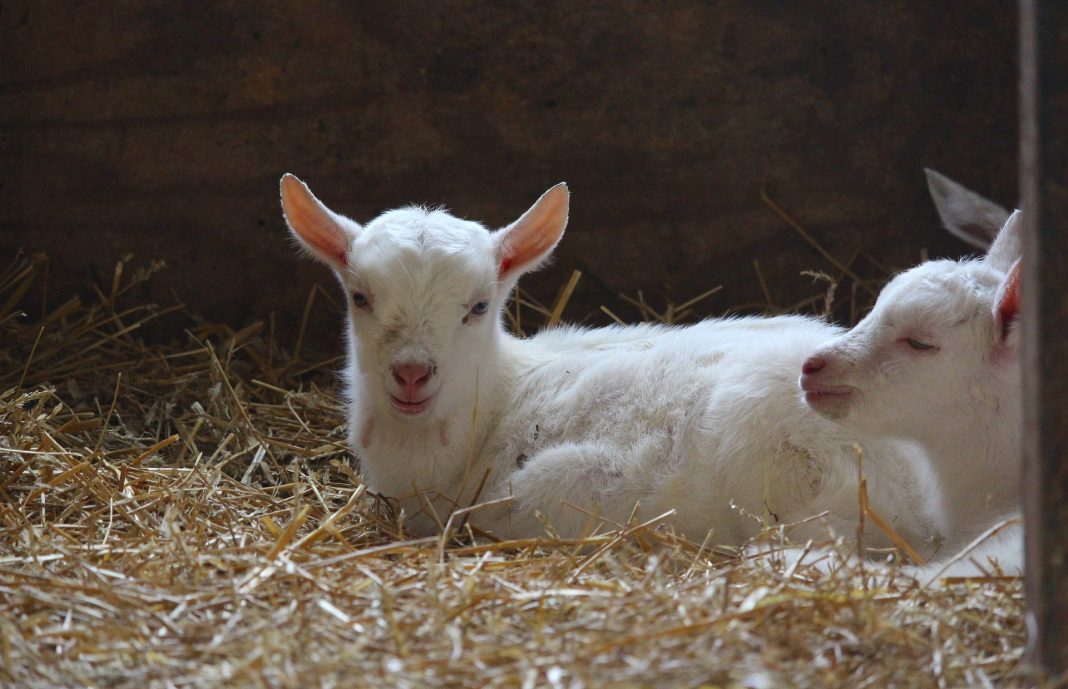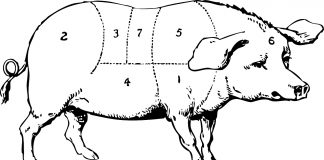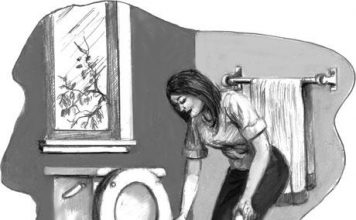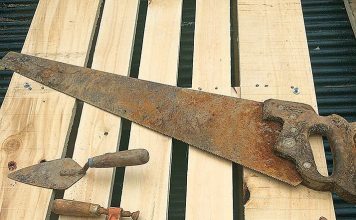| By Jackie Clay |  |
| Issue #112 • July/August, 2008 |
Dairy goats form one of the cornerstones of our homestead. Not only do they provide milk, cheese, ice cream, cottage cheese, and meat, but they also give us manure for our gardens and provide entertainment, too. They’re smaller and easier to handle than cows, eat less, and they really like people. When our goats occasionally get out they don’t run away down the road looking for more cowswe’re more apt to find them up on the porch, peering in the windows, wondering when we’ll come out to take them for a walk.
Because they are such a beneficial animal on the homestead, I’ve always kept them. At one time I had a commercial dairy, milking nearly a hundred does and selling milk to a cheese plant. Now days I’ve cut back to what is enjoyable for me. I have two adult does, three doe kids, our pet wether, Oreo, and a big Boer buck.
In order to keep a supply of milk, I breed my does to freshen at different times. In order to have a doe milking, she must be bred and freshen (give birth). While some does have milked for years following a birth, it is not common; milk production usually starts to slack off after about eight months. This is the natural way a goat’s body prepares for the next pregnancy and freshening, letting the body catch up on nutrients and rest from the stress of milking.
Care of the pregant doe
A doe goat’s gestation time is about 150 days or roughly five months. About two months before her due date, she should be dried up. There are several different opinions about how this should be done. If she is a heavy milker, you can switch to only milking her once a day for a couple of weeks, then simply stop milking her. Her bag will enlarge, but unless it gets really full or seems hot, she will soon absorb the milk and the udder will shrink down in its rest mode. If she has had mastitis in the past, evidenced by chunks in the milk like small bits of cottage cheese, it’s a good idea to use a dry udder infusion as she goes dry, to help prevent a flare-up of mastitis. If not, simply leave her udder alone; the more you milk her and fool with her teats, the more she’ll be stimulated to produce more milk.
|
As she gets advanced in her pregnancy, her sides will begin to round out and protrude. You’ll most likely notice this around four months. It’s a good idea to give her boosters on her enterotoxemia and tetanus vaccinations at this time and make sure she is wormed. Ask your vet for his advice. In some areas that are selenium deficient, white muscle disease is common. This causes newborn kids to lose control of their legs and often die. A simple injection for the doe before birth, followed by one for the new kids a week or ten days after birth, will prevent this.
Be sure that especially during the last month of her pregnancy she gets a good mixed goat grain. Without it she will not milk well, nor will she have large, healthy kids that will go on to make great milkers or meat for the family. A constant fresh water supply is also necessary. Goats are very clean and will not drink water with dirt or manure in it until they are just about dying from thirst.
Have a birthing stall ready for your pregnant doe. While many does have kidded in the herd, you always run the risk of having one of the kids injured, either by accident or because of an aggressive adult. The mother can be very nervous at birth, and while trying to protect her newborn kids, she can step on them while she circles about, chasing the other goats.
The birthing stall doesn’t need to be large; five feet by six feet is plenty large. It confines the doe so she doesn’t get far away from her kids, yet allows her plenty of room to move around. The birthing stall can also be used to either house the mother with her kids for a few weeks until they are strong enough to join the herd or the kids alone, should you choose to bottle raise them. Needless to say, it should be very clean and have plenty of nice fresh bedding laid down in advance.
About a week before the impending delivery, you’ll notice that the doe’s belly suddenly changes; it becomes more pendulous and the back area looks more bony. The kids are changing position in the uterus, getting ready for birth. Her udder has been slowly getting bigger, but during the last week, it usually will round out much more, or bag up.
It’s a good idea to put the doe in the birthing stall about two weeks before her due date, or when she starts bagging up, so she gets used to it and is relaxed in her surroundings. Don’t leave a water bucket in the stall; either have a hole cut in the stall wall so she can reach through to drink or offer her water twice daily. I’ve seen kids born right in the water pail and drown.
A day or so before delivery, her bag will usually suddenly spring tight, with her teats looking full and shiny. Sometimes they’ll jut out or even leak a little milk. The ligaments on either side of her tail will loosen and her back will look more thin.
Kidding day!
On the day of her delivery, her vulva will look loose and larger, often having mucus strings hanging from it. She’ll begin to act restless and may paw bedding into a nest and circle about nervously. As she begins labor, she will lay down, get up, walk around, lay down, and repeat this several times.
With most deliveries, she’ll go into heavy labor, moaning and bleating as the contractions get stronger. You’ll notice a “black ball” protrude from her vagina. This isn’t a kid’s head, but her water bag. It soon bursts and with further contractions, you will usually see a kid’s nose and two front feet coming out. The tongue may be out; don’t worry.
In a few minutes and after several more strong contractions, the kid will be expelled quite quickly, sliding out onto the bedding with a gush of fluid. If the head is still covered by membrane, take a towel and dry it off, including inside its mouth if it seems to be sputtering and coughing mucus. Holding it up briefly by the hind legs will also let any mucus drain from its throat and mouth. Tie off the umbilical cord about an inch from the belly with strong, sterile thread, cut the cord just past the thread and dip the umbilical stump well with Betadine. Then let Mom lick the baby dry and bond with it.
A single kid is often the case with a first freshener (a doe that is having her first birthing), but with older does, you can expect everything from a single kid to quadruplets.
When she has finished giving birth, she will expel the afterbirth. Let her lick and chew on it a little; this is natural and will help stimulate her milk production and letdown. Few goats will completely eat the afterbirth, so dispose of the rest so it doesn’t contaminate the stall.
There are two normal birth presentations seen in goats. The first and most common is the head and two front feet coming first, in a “diver” position, with the feet pressed against the head. The second is the hind legs first, hocks up, with the buttocks following. A doe seldom needs much help with either of these, except when the kid is very large.
Sometimes, you’ll find only one front leg and the head (other leg is back), or both front legs and no head (head and neck are turned back on the pelvic outlet), tangled twins (legs of two different goats), or buttocks first and no legs (the hind legs have folded forward). These are abnormal birth positions and must be corrected before the kids can be born. Either call your veterinarian immediately or soap up your hand. It doesn’t matter if you are the brave, adventurous sort or a chickenif the vet isn’t available, go in to help her deliver her kids.
Luckily, a kid is much smaller than a calf, so you can usually adjust the problem position without much strain. Just be sure that the limbs you are working with belong to the kid that is being delivered! You’ll usually have to push the kid back in a little in order to grasp the wayward leg or head, but once in position, it will usually be born with little more problems. The longer it is before help is administered, the more danger there is that the kid will die before it is delivered.
The only other problem you may run up against at birth is the doe not expelling her afterbirth. The doe usually expels her placenta shortly after giving birth or up to a few hours afterward. Keep track of this; don’t let the afterbirth become lost in the bedding. Be sure she has expelled it. If she doesn’t, it is usually evident, as it hangs from her vagina, often down to her hocks. It is a thickish red membrane that hangs in a stringy mass.
If she hasn’t expelled it in 12 hours, call your veterinarian. Often an injection of oxytocin is all that is needed to encourage her uterus to release it. This is a natural hormone and will also increase her milk flow.
For more information on aiding difficult births and other kidding-related health issues, pick up A Veterinary Guide for Animal Owners, from the BHM bookstore.
Care of newborn kids
If the weather is cold, a heat lamp is a good addition to the birthing stall. Be absolutely sure that the lamp is tied securely so it positively cannot fall into the bedding. Many barns have burned down because heat lamps have fallen into the straw and caused it to ignite. Put it in a corner where the doe can’t get at it and the kids will soon learn where the heat is. The heat lamp will ensure that the kids get dried off well and it’ll prevent hypothermia. In very cold weather, it will also keep their ears and feet from becoming frozen. If they do freeze, they will eventually turn black and fall off. Not a pretty option.
Should this happen when a doe freshens unexpectedly in cold weather, you can sometimes save the ears or feet by immediately bringing the kid into the house and submerging it in warm (not hot) water, including the ears if they are stiff. Keep the kid in the house or where it is reliably warm for several days to a week or more. The circulation will be impaired and the extremity will be much more prone to refreezing. Do not rub snow into the area and do not rub the area at all, as it is very prone to damage at this point.
Soon after birth, the kids usually will struggle to their wobbly feet and search for milkusually at the wrong end of Mom. But soon they’ll find the teat and start to suck. Sometimes, especially with does with large, pendulous teats, new kids can’t find the teat or figure out how to get it bent around into their mouths. You may need to help a little here. I’ve even had to nearly milk out a doe’s udder so that the new guys could get hold of the teat. They won’t nurse much or long, but as long as they do get a snack, they’ll be alright for several hours.
|
The first day and night are important; be sure the kids are nursing and getting milk. Look for the little wagging tails, and you’ll know they are being satisfied. Newborn kids will nurse fairly often, but not long at a time. That will increase, and they’ll nurse less often and get more milk at one time. If the doe’s bag is enlarged and her teats full, even after the kids nurse, milk her nearly dry. Leave just enough for the kids to nurse, but don’t leave her bag full or she’ll be very prone to developing mastitis or an udder infection. This can ruin a good doe.
Once in a while, you’ll have a doe that simply won’t let her kids nurse. Maybe her udder is painfully tight. Maybe she’s a new Mom and hasn’t figured things out yet. Or maybe she just decided she doesn’t want to be sucked. She’ll whirl away from the kid that’s trying to find the teat. Maybe she’ll bite or butt the kid, paw or kick at it.
Sometimes you can tie the doe to the wall and shove her body tightly against it to immobilize her while you help the kid to nurse. Often, if you do this several times, then offer the doe grain while supervising the nursing, she’ll reluctantly allow the kids to nurse.
But once in a while, a doe simply won’t let the kids nurse and you’ll have to bottle feed them from the start. Or you just want to bottle raise them so they’ll be very tame and friendly. Another reason some people bottle feed kids is to prevent CAE (Caprine Arthritis Encephalitis). This disease is fairly common in goats and shows as hind limb paralysis in young kids, head tilting or circling, and death in older animals, and probably most common, “knobby” knees and crippled jointsthe “arthritis” part of the syndrome. It can’t be successfully treated. It is passed through the milk, especially the colostrum from an infected doe to her kids. So to ensure a herd is CAE free, goat breeders often rear the kids from birth on colostrum and milk that has been heated to between 133 to 139° F for one hour. This effectively kills the virus which causes CAE but does not destroy the vital antibodies in the milk.
If you plan on bottle raising your kids, get special kid nipples. These are softer than the old black “lamb” nipples that slip on pop bottles. And they come with an air vent that allows the kids to nurse without creating a vacuum that collapses the nipple flat. You can get several different styles of these nipples through many goat suppliers. I get mine through Hoegger Goat Supply (www.hoeggergoatsupply.com).
Newborn kids will not nurse much at a time. If you get them to suck the nipple several times, that’s good enough; offer them more in two hours. It is important that they do nurse. Some kids don’t like the artificial nipple and refuse to suck. Or they are chilled or weak and can not suck. In this case, you need to take immediate steps to save the kid’s life.
First make sure the kid is warm enough. Just having the kid in the warm house is not enough. You must supply supplemental heat via a heat lamp or heating pad under the blanket that the kid is laying on. Sometimes just warming the kid up is enough to get it going. Many a shepherd has saved weak and chilled lambs by putting them next to the wood kitchen range in an old farm kitchen.
Try putting your finger in the kid’s mouth, then slip the nipple in and gently hold its head and nose with your forefinger. This often stimulates them to suck.
If the kid just won’t or can’t suck, it must be tube fed. You’ll need a feeding tube, which is a flexible plastic tube that fits onto a large syringe. To tube feed, first draw the warm milk up through the tube, into the syringe. Then “eyeball” the kid, figuring out how far it is from its mouth to its stomach. Slowly slide the tube down the kid’s throat, letting it swallow as you push gently. When you think it is far enough, slowly squeeze a little milk down the tube. If the kid struggles violently or coughs, retract the tube at once; you’ve gotten into the lung! This doesn’t happen very often, but it can happen. Let the kid swallow and it won’t occur.
When milk comes out of the kid’s mouth, you need to push the tube a bit farther down its throat. Then slowly inject the milk. A new kid needs at least 20 ccs of warm colostrum at a tube feeding. Don’t overdo it; wait two hours and feed the kid again.
Often the kid will be up, hollering for breakfast after only one tube feeding. What a change a few tablespoonfuls of milk can make! Keep her warm and fed every two hours until she is acting normal, then offer the bottle; she’ll usually very willingly accept.
At this point, you can feed four times a day, about ½ a pint at a feeding. You want the kid to still be hungry when the milk is gone, but not starving. Too much milk can cause diarrhea; too little and the kid will not grow nicely. As the kid gets a few days old, you can feed twice a day, but give more milk, up to a pint at a feeding.
Disbudding
Very few goats are born naturally polled (hornless from birth). Yes, horns are natural, but goats used to be wild animals and roam in herds. They needed the horns to protect themselves from predators. Today, goats are not wild and they are milked and otherwise handled by people. And they are kept in fences, led with collars, and otherwise domesticated. Horns are now a danger to goats and their handlers.
A horned goat can always squeeze its head through a fence square (field fencing or welded stock panel), but very, very seldom get back out. Sometimes they will strangle in the attempt to free themselves. I’ve seen a horned doe hook a kid and catch its front leg in the V of her horns, breaking its legeven her own kid! A horned goat can catch its horn in its own collar or one of another goat, choking it to death. A horned goat doesn’t fit into a keyhole manger or an average milking stand.
And, of course, a horned goat can hurt you. It may not mean to, but when it swings quickly around to bite a fly, it can smash your face in a heartbeat. Or when you are leading it and it doesn’t want to go, a twist of its head and your knuckles are bleeding.
It is very difficult to dehorn an adult goat, so it’s best to disbud the kids soon after birth. This is done with a disbudding iron that heats up like a branding iron and fits down over the horn bud, burning the skin down to the skull. This sounds horrible, but minutes afterward the kid is playing with you and nursing its dam unconcerned.
When using the iron, make sure it is heated up well; if it is not you won’t get a good disbudding and the kid may grow scurs. These are little, misshapen horns that the goat will spend a lifetime catching on things, breaking them off, bleeding, and looking untidy at best.
The kids are best disbudded between three and four days. The longer you wait, the more chance you’ll have for scurs to grow, as the horn buds will have started to grow. Place the kid in a tight disbudding box or have an assistant hold the kid snugly in their arms, restraining the kid’s head with a gloved hand. (Occasionally the person doing the disbudding will slip and touch the assistant’s hand with the iron; the glove is necessary protection! )
|
Repeat to yourself, “I’m saving your life… I’m saving your life…” as you press the hot iron down on the trimmed hair over the horn bud. Keep pressing down firmly and don’t breathe. It stinks! Slowly rotate the disbudding iron so that all of the surface of the skin is burned. Then lift the iron. There should be a white ring completely around the horn bud, with the “fried” horn bud sticking up. Flip the black cap off it with the iron and apply the iron again for a shorter time. Repeat with the other side.
I like to have a bucket of snow or shaved ice handy to slip on the kid’s head when I’m done. At the time you disbud, it’s a good idea to give the kid its first tetanus vaccination. While it isn’t common for a kid to get tetanus after disbudding, it can happen and it pays to be safe.
Feeding the kids grain and hay
It’s amazing how fast new kids will eat grain and hay, if it is available to them. Some people don’t offer these solid foods to new kids because they are still on the bottle. I’ve raised goats most of my life and was still amazed when our new triplet does started nibbling hay at four days and now, at two weeks of age, are eating grain and hay like old-timers.
Eating solid foods helps the rumen (the fermentation chamber of the stomach) develop, and the earlier this happens, the better growth you can expect from your kids. Keep good quality hay available to the kids at all times and offer a good mixed grain with molasses (kids like their sweets) twice a day. Clean up the leftovers and give them to the chickens.
Of course, if the kids can be on pasture, they’ll also begin to munch on clover, brush, and grass from a very young age. Be sure that the pasture is clean, not one that is heavily used by adult animals and littered with copious amounts of manure. By eating in such a pasture, your young kids will be picking up worm eggs and quickly be parasitized. This will harm their growth and make them more prone to illness.
Even when the kids are on the bottle, be sure they have clean, fresh water available in a drown-proof pan. Water has been called the “cheap feed,” as plenty of water helps build big, sturdy animals.
Goat birthing and kid raising is an enjoyable part of homestead living and it feels good to be a part of this natural cycle of rebirth. Every kidding on our homestead feels like a cross between Christmas and the Fourth of July. You’d think that after all these years of goat raising I’d get ho-hum about the process, but every time it’s fresh, new, and oh so exciting. Enjoy your babies!

















